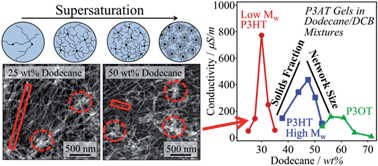Controlled gelation of poly(3-alkylthiophene)s in bulk and in thin-films using low volatility solvent/poor-solvent mixtures†
Abstract
Low volatility solvent/non-solvent mixtures were utilized to engineer the structure of poly(3-alkylthiophene) (P3AT) organogels. The ratio of solvent to poor-solvent was manipulated to systematically control the kinetics of self-assembly. Specific solvent mixtures were utilized to produce similar gelation kinetics with polymers of differing alkyl chain length. Simultaneous small angle neutron scattering (SANS) and dielectric spectroscopy was used to probe the structure and the electronic properties of isothermally self-assembled P3ATs. It was determined that alkyl chain length has a dominant effect on the relationship between fiber development and conductivity. Furthermore, using transmission electron microscopy (TEM) and SANS we demonstrate that, for P3HT organogels, lower poor-solvent content leads to fewer fibers with larger nucleation centers while higher poor-solvent amounts results in more fibers and nucleation centers that are smaller and more abundant. This leads to opposing effects in terms of the contribution of the solvent quality to the electrical conductivity. An optimum in conductivity is found at different amounts of poor-solvent for each type of polymer. It is also shown that low volatility solvent mixtures allow for the formation of thermoreversible conjugated polymer organogels in thin-films at room temperature. This work highlights the potential to engineer the structure of conjugated polymer organogels while enabling the use of interconnected gel structures in thin-film organic electronic devices.


 Please wait while we load your content...
Please wait while we load your content...